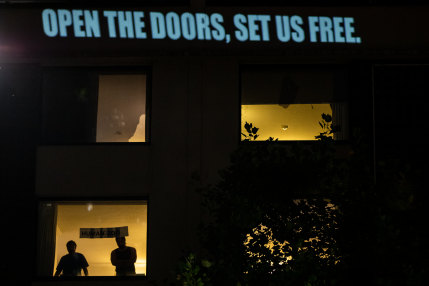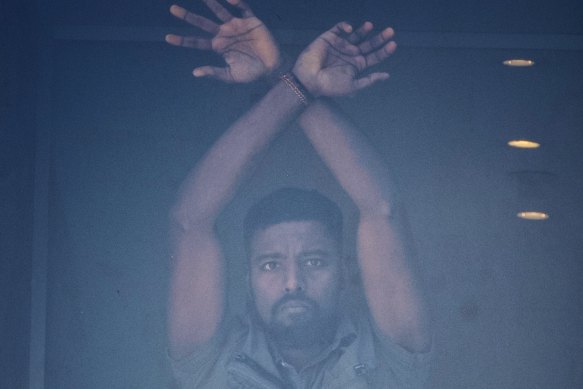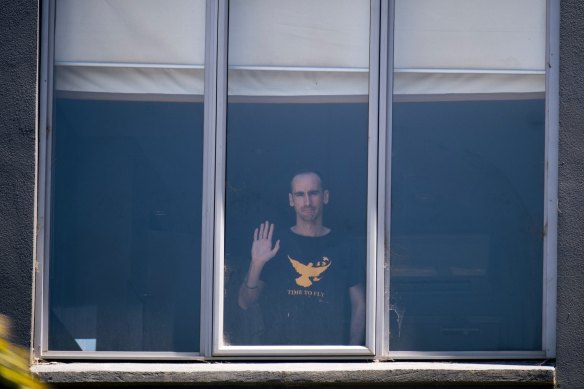This was published 3 years ago
Opinion
The cold-hearted calculus behind the Park Hotel prison
Bianca Hall
Environment and climate reporterWhat exactly was the point?
The wasted years locked up in hotel rooms, behind tinted windows that wouldn’t open to let in fresh air and sunlight. People growing paler, sicker and more broken.

Refugees stand behind tinted windows at Carlton’s Park Hotel in Melbourne.Credit: Diego Fedele/Getty Images
One man, Ismail Hussain, said he spent his days at Melbourne’s Park Hotel lying on his bed. He took sleeping tablets day and night to make the time pass more quickly.
On Thursday, this ugly era at the Park Hotel finished, its eight remaining refugees released into the community. Another 12 refugees were released from detention in other centres around the country, including six in Brisbane.
If they could be released now, why not two years ago? What was the point?
Hundreds of people were rushed from Papua New Guinea and Nauru to Australia in 2019 for emergency medical attention on the advice of doctors, under the short-lived medevac legislation.
They came with post-traumatic stress disorder, rotting teeth, chest pains, suffering the after-effects of suicide attempts (including one man who had set himself on fire and suffered extensive internal and external burns) and other debilitating conditions.
They may have expected to receive medical care. Instead, as then home affairs minister Peter Dutton confirmed to Sydney radio station 2GB last year, “many of these people didn’t receive any medical treatment”.
Rather, Mr Dutton said, their transfer to Australia was “all about [former Labor leader] Bill Shorten at the time trying to do a deal with the Greens in bringing people into our country”. Instead of medical care, the people remained locked up in hotel rooms and immigration transit centres, their anguish growing day by day.
The cruelty was the point. That their plight might deter others from coming to this country by boat.

A refugee being held at the Mantra Hotel in Preston in 2020.Credit: Luis Enrique Ascui
The Age and The Sydney Morning Herald revealed in 2019 the Mantra Hotel in Preston had been used for months as a makeshift detention centre for men evacuated from offshore detention.
The Human Rights Commission inspected conditions at the hotel and concluded that they were not appropriate places of detention, given their lack of dedicated facilities, restrictions on freedom of movement and access to open space.
Since December 2020, some 230 people have been released in small groups, leaving about 10 medevac refugees still in detention.
They are generally released on temporary bridging visas, which give them no study rights. They are, however, permitted to work and to pay taxes in this country, which has left them in punitive limbo.

A lonely view: Moz Azimitabar in the Mantra hotel in Preston in December 2020.Credit: Luis Ascui
On July 19, 2013, former prime minister Kevin Rudd declared that no one who arrived by boat would ever settle in Australia, effective that day.
That declaration led to thousands of people – many of whom were in Indonesia or en route to Australia – being caught in a cruel limbo with no end in sight. One that the Turnbull, Abbott and Morrison governments have shown little interest in ending.
And yet, on the eve of a federal election, most of the refugees are free.
Mehdi Ali, who came to Australia aged just 16, spent almost a third of his young life locked up at Australia’s hands.
During his time at the Mantra, Mehdi became a public face of the struggles of the men locked inside. He secured a coveted US visa in March, and flew to freedom in Minneapolis.
But freedom is a relative concept to people who have been so damaged by their treatment at Australia’s hand.
I spoke to him last month and asked him how he was feeling now he was free.
“I was a child,” he said. “I ended up in jail and I was in jail for nine years.
“Some people are saying, ‘you have arrived [in the US] – be happy!’ but it’s more complicated than that. It’s not a Hollywood movie. Nine years are gone and now I’m free. Then, why? Why? I had to wait for nine years. For what crime?”
Fascinating answers to perplexing questions delivered to your inbox every week. Sign up to get our new Explainer newsletter here.